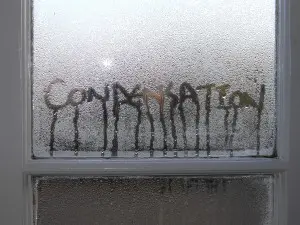OCTOBER 2016
CONDENSATION SEASON IS HERE AGAIN!
Condensation can be a significant problem for homeowners in the winter months as the external air temperature falls, water from the air forms as condensation on cold surfaces such as windows and external walls. This usually occurs between October and April.
Why does condensation occur in the home?
Condensation occurs when moisture in the air forms water droplets on cold surfaces like windows or outside walls. Problems with condensation are worse during cold weather. The moisture in the air comes from a number of sources within the home, including cooking, bathing, breathing, washing and drying clothes. A five person household can generate about 10kg of water every day.
What are the problems caused by condensation in the home?
Excessive condensation can lead to extensive mould growth, which in turn can lead to unhealthy and unpleasant living conditions, as well as damaging furniture and clothing. Condensation can sometimes occur within the structure of a wall (interstitial condensation) leading to damp issues.
Condensation dampness is frequently misdiagnosed as rising or penetrating dampness. Correct diagnosis of condensation issues is essential to ensure effective control.
Typical signs of excessive condensation in the home
- Streaming windows
- Water pooling on window sills
- Damp walls with no ‘tidemarks’
- Damp and mould patches
- Mould in corners of rooms
- Mould behind furniture
- Mildew on clothes & furnishings
- Musty and damp smells
HOW TO CONTROL CONDENSATION
Condensation occurs when heating, ventilation and insulation are out of balance, and therefore the key to controlling condensation is to address one or more of these issues.
Lifestyle changes to reduce condensation problems
- Dry clothes outdoor or in a tumble dryer. If you must dry clothes indoors make sure the room is well ventilated or use a dehumidifier whilst clothes are drying.
- Ventilate bathrooms and shower rooms externally during and after use, keeping door closed.
- Ventilate the building by opening windows, keeping ventilation strips on windows open and using extract fans.
- Maintain an even temperature within the building. Avoid periods of very high or very low temperatures.
- Use an extractor fan when cooking or bathing
Building improvements to reduce condensation problems
- Improve insulation of lofts and cold walls
- Re-position or upgrade radiators in cold areas
- Upgrade existing ventilation fans with run on timers or humidistat controls
- Add ventilation strips to double glazed windows
- Fit new passive or mechanical ventilation to kitchen, bathroom and utility room
- Fit whole home ventilation systems
Based in Reading, Berkshire, Biocraft offers condensation control services throughout Berkshire, Hampshire, Surrey and Oxfordshire. We can cure condensation problems in Reading, Newbury, Hungerford, Oxford, Basingstoke, Bracknell, Maidenhead, Henley on Thames, Marlow, Slough, Windsor, Ascot, Sunningdale and other locations within Berkshire, Hampshire, Surrey and Oxfordshire.
Biocraft is a member of the Property Care Association (PCA), the Federation of Master Builders and Construction Line. Biocraft is an approved installer of Nuaire home ventilation products.
For advice on condensation control or to arrange a condensation survey please call 0118 943 2111 or email info@biocraft.co.uk


